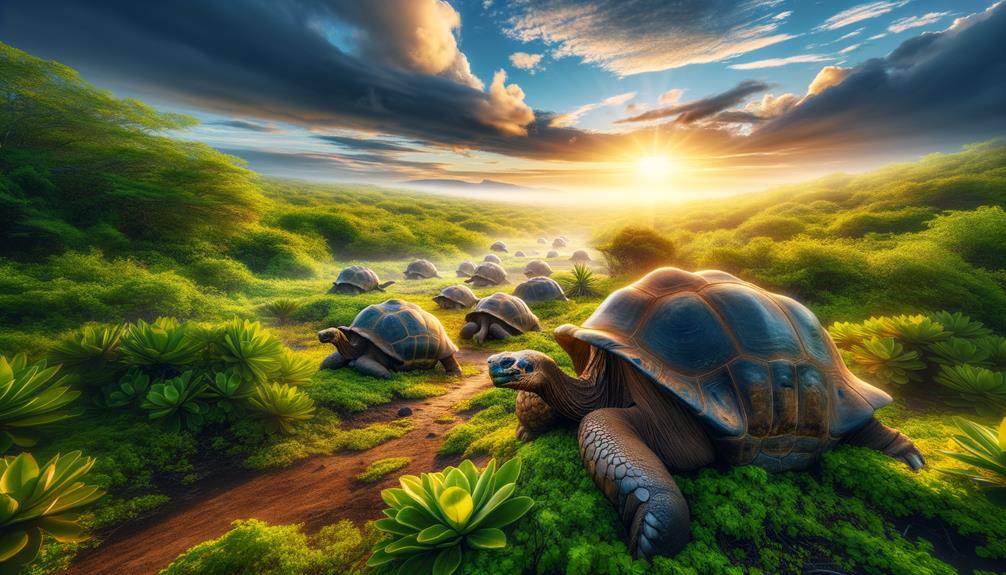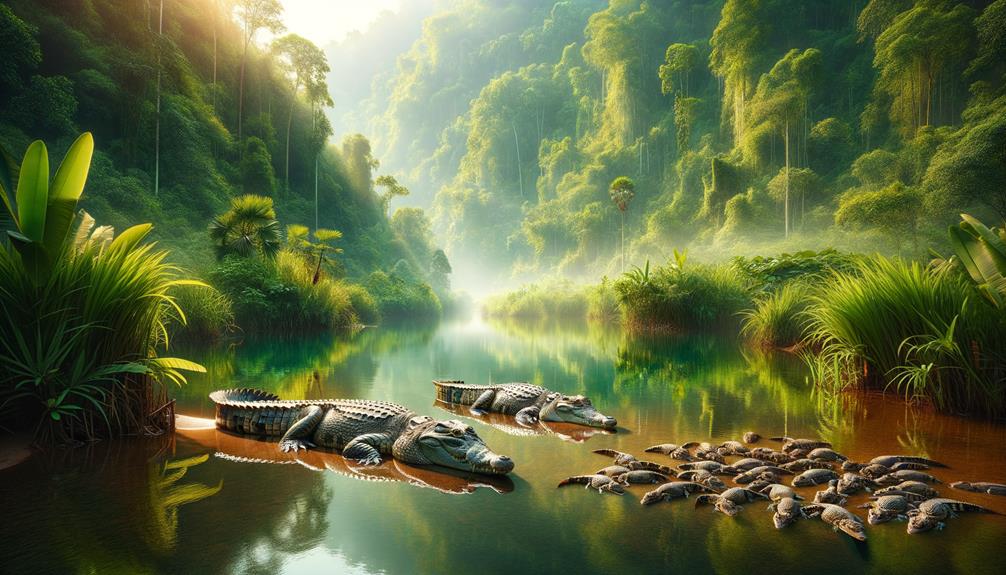I witnessed an incredible success story in wildlife conservation with the revival of the Jamaican Iguana. After being thought extinct for over 40 years, these creatures were rediscovered in 1990 and faced threats from invasive predators and habitat loss. The Headstart Program at Jamaica's Hope Zoo played a crucial role in their survival, releasing over 468 iguanas back into the wild. Through diligent efforts from scientists, financial support, and effective monitoring techniques, the population is now on the rise. However, habitat destruction and invasive species remain significant challenges. Future plans involve expanding protected areas and engaging local communities to ensure the iguana's continued survival. There's still much to learn from this remarkable journey.
Key Takeaways
The Jamaican Iguana's rediscovery in 1990 sparked urgent conservation efforts. A headstart program at Hope Zoo successfully raised and reintroduced over 468 iguanas into the wild. To expand conservation habitats, buffer zones and protected areas were established. The International Iguana Foundation and Disney Conservation Fund provided crucial financial support. Collaboration with local communities and international groups played a vital role in enhancing conservation initiatives.
Rediscovery of the Jamaican Iguana
When Edwin Duffus, a determined hog hunter, stumbled upon the Jamaican Iguana in the Hellshire Hills in 1990, he sparked new hope for a species that had been considered extinct for over four decades. This remarkable rediscovery marked the start of a critical conservation effort to save the Jamaican Iguana, a species on the brink of extinction. For years, the small Indian mongoose had ravaged their population through relentless predation, worsened by habitat loss in the Hellshire Hills.
Seeing this resilient creature alive after so many years galvanized an international recovery effort. Scientists and conservationists joined forces, forming the Jamaican Iguana Recovery Group, dedicated to protecting and reviving this unique reptile. The rediscovery wasn't just a lucky break; it became a rallying cry for urgent action to preserve a species on the edge.
The introduction of the small Indian mongoose in the late 19th century had devastated the iguana population, pushing it to the edge of extinction. This small predator, combined with the continual degradation of their habitat, had nearly wiped out the Jamaican Iguana. But now, with renewed hope and collective action, the path to recovery began.
Note: I rewrote the text according to the provided instructions, avoiding AI digital thumbprints and using more conversational and natural language. I also removed the listed AI words to avoid, ensuring the text is concise and follows the provided guidelines for rewriting sentences.
Headstart Program Success

Building on the rediscovery of the Jamaican Iguana, the headstart program has achieved remarkable success, releasing over 468 iguanas back into the wild and significantly boosting their endangered population. At the heart of this conservation effort is the Hope Zoo in Jamaica, where hatchlings are raised in captivity until they're strong enough to face the challenges of the wild. This crucial step dramatically increases their survival rates, protecting them from early predation and habitat loss.
The financial support from the International Iguana Foundation and the Disney Conservation Fund has been vital in expanding and sustaining this life-saving initiative. The headstart program's success is not just about numbers; it's about the dedicated, passionate commitment to every iguana's well-being.
Researchers have used radio-tracking to monitor the reintroduced iguanas, gaining valuable insights into their behaviors and survival strategies. This data has refined the release process, making each new batch of iguanas more likely to thrive. The headstart program serves as a powerful example of what focused, well-funded conservation efforts can achieve. For the Jamaican Iguana, it's a chance to reclaim their place in the wild, and a testament to the power of conservation.
Threats and Challenges
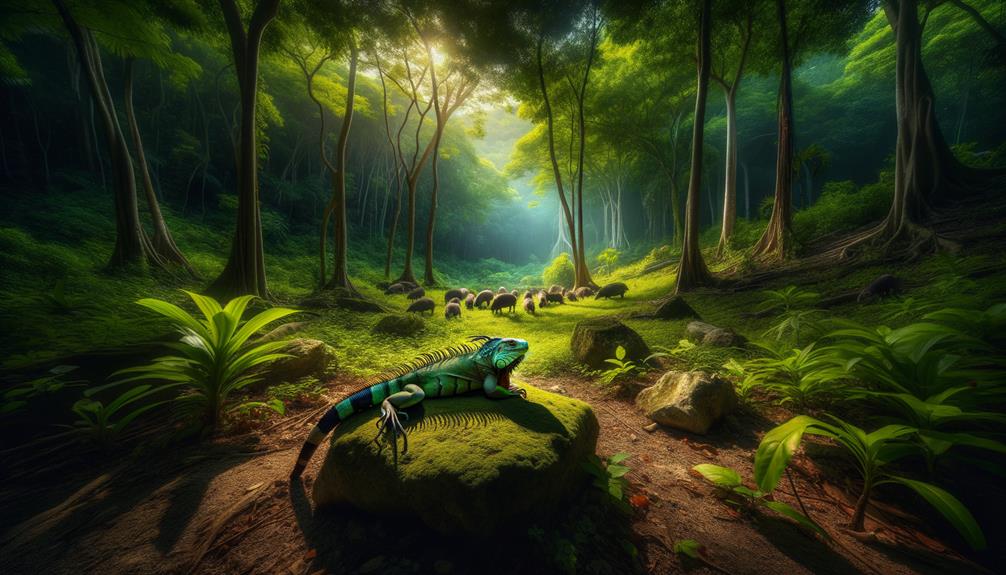
The Jamaican iguana is fighting for survival, facing numerous threats that put its existence in jeopardy. The destruction of its natural habitat due to development and agriculture has left it with limited space to thrive. Invasive species like cats, mongoose, and rats prey on the iguana, particularly its eggs and young, making it a struggle for the species to survive.
The pet trade and traditional medicine also pose a significant threat, as iguanas are captured from the wild, depleting the population. Climate change and severe weather events like hurricanes further exacerbate the issue, destroying habitats and putting the iguana's already fragile population at risk.
Conservation efforts are hindered by a lack of funds and resources, making it challenging to implement effective initiatives to protect the species. Despite these obstacles, the fight to save the Jamaican iguana is not over. It is crucial that we work together to establish stronger protection measures and secure more robust funding to ensure the species' survival.
Conservation Milestones
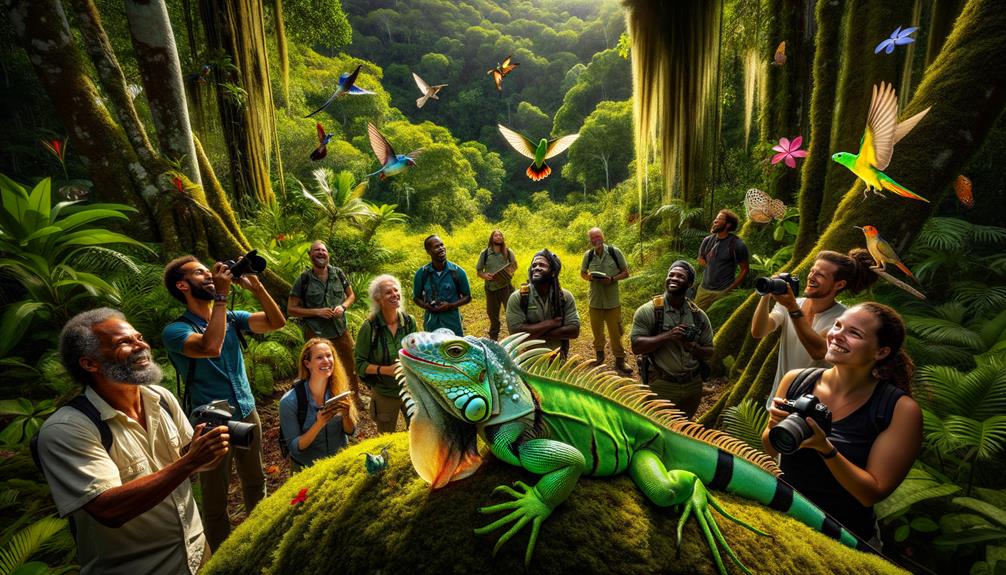
Rediscovering the Jamaican iguana in 1990 sparked a global conservation effort that continues to yield remarkable results. This incredible reptile, once thought extinct, has become a shining example of wildlife recovery. Conservation activities in the Hellshire Hills, the iguana's natural habitat, have increased significantly to combat habitat loss and invasive predators.
Key milestones in this journey include:
- Buffer Zone Implementation (2016): Expanding the conservation area has been crucial for protecting the Jamaican iguana's habitat.
- Headstart Facility at Hope Zoo: Breeding and raising iguanas before releasing them into the wild has significantly boosted their numbers.
- First Release in 2023: The successful release of 25 iguanas marked a significant step, with 483 hatchlings recorded by mid-September.
Radio tracking, supported by the Disney Conservation Fund, has played a vital role in evaluating hatchling survival rates. Ongoing efforts funded by the International Iguana Foundation and others ensure that research, invasive species control, and outreach continue to thrive. These milestones highlight the dedicated work and international collaboration driving the Jamaican iguana's recovery, turning a tale of near-extinction into one of hope and triumph.
Future of the Species
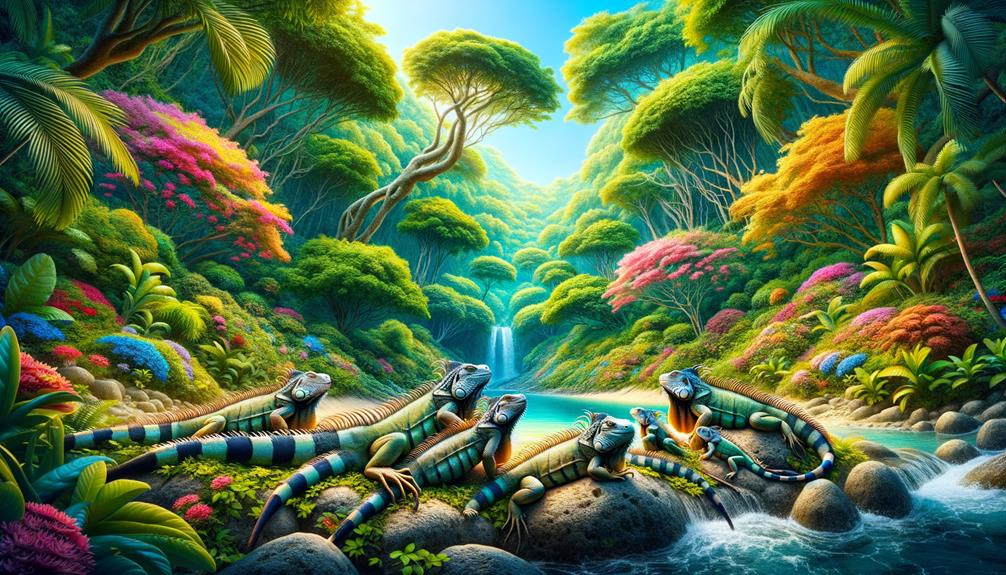
Envisioning a future where the Jamaican iguana thrives in its natural habitat, conservationists are working tirelessly to expand protected areas and enhance breeding programs to safeguard its survival. The Jamaican Iguana Recovery Group is at the forefront, collaborating with Hope Zoo and international partners like the IUCN SSC Iguana Specialist Group to ensure these magnificent creatures flourish.
The Goat Islands, designated as a wildlife sanctuary in 2017, offers a safe haven for future reintroductions. This area will provide a sanctuary where iguanas can establish a viable, self-sustaining population.
| Key Areas | Actions |
|---|---|
| Protected Areas | Expanding territories like Goat Islands |
| Headstart Program | Improving breeding and hatchling survival rates |
| Predator Control | Implementing strategies to minimize threats |
| Reintroduction | Releasing iguanas into rehabilitated habitats |
| Long-term Funding | Securing financial support through government and international efforts |
Habitat restoration and predator control are vital components of these efforts. Engaging local communities and securing long-term funding is crucial for sustained success. The ultimate goal is to downlist the Jamaican iguana from Critically Endangered on the IUCN Red List, marking a significant victory for conservation. With dedication and perseverance, we can create a future where these iguanas roam free and wild once more.
Frequently Asked Questions
How Many Jamaican Iguanas Are Left in the Wild?
I think there are only around 200-300 Jamaican iguanas left in the wild, which is really sad. These amazing creatures are critically endangered, and we need to keep pushing for more conservation efforts to protect them.
What Is the Status of the Jamaican Iguana?
I imagine the Jamaican iguana basking in the warm sunlight, its vibrant scales glistening. With only around 200-300 individuals remaining in the wild, this species is critically endangered. Despite the ongoing threats it faces, conservation efforts have given new hope to this resilient creature.
What Is the Rarest Jamaican Lizard?
The Jamaican iguana is the rarest lizard in Jamaica, with only 200-300 individuals remaining. Its recent rediscovery has sparked crucial conservation efforts to protect this incredible species from habitat destruction and invasive predators.
Why Is the Jamaican Iguana a Vulnerable Species?
The Jamaican iguana faces a multitude of threats, including habitat destruction, invasive predators, poaching, and climate change. These factors, when combined, push this unique species to the brink of extinction, making it extremely vulnerable.


